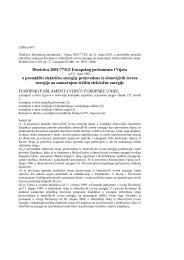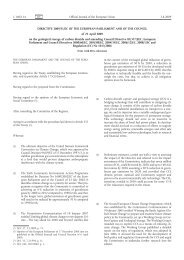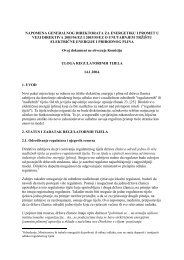Create successful ePaper yourself
Turn your PDF publications into a flip-book with our unique Google optimized e-Paper software.
Rezerve ugljena u pljevaljskom podruËju mogu<br />
zadovoljiti potrebe termoenergetskih postrojenja<br />
za proizvodnju elektriËne i toplinske energije, kao<br />
i za πiroku i industrijsku potroπnju u Crnoj Gori u<br />
iduÊih 70 do 80 godina. Geoloπke rezerve ugljena<br />
u beranskom bazenu zahtijevaju dodatne istraæne<br />
radove radi poveÊanja eksploatacijskih rezervi.<br />
TrenutaËno stanje poduzeÊa za eksploataciju<br />
ugljena je problematiËno, kao posljedica restrukturiranja<br />
gospodarstva i nestanka velikih potroπaËa<br />
ugljena. Stoga se ulaæu napori da se kroz procese<br />
privatizacije rudnika osigura njihovo dugoroËno<br />
stabilno poslovanje. Rudnik ugljena Pljevlja<br />
raspolaæe proizvodnim kapacitetom od 1,5<br />
milijuna tona godiπnje, od Ëega 1,35 milijuna<br />
tona koristi TE Pljevlja, a 150 tisuÊa tona πiroka<br />
potroπnja. Rudnik ugljena Ivangrad ∑ Berane<br />
u novije vrijeme radio je s kapacitetom od oko<br />
65 tisuÊa tona godiπnje, s tim da je posljednjih<br />
nekoliko godina proizvodnja u zastoju zbog velikih<br />
poslovnih problema.<br />
Energetski potencijal ugljena u Crnoj Gori moguÊe<br />
je u buduÊnosti kvalitetno realizirati proizvodnjom<br />
elektriËne i toplinske energije, πto Êe najviπe<br />
ovisiti o strategiji razvoja elektroenergetskog<br />
sustava, toËnije njegovog proizvodnog dijela. Zbog<br />
realnih okolnosti, proπirenje kapaciteta oËekuje<br />
se u pljevaljskom bazenu, a to za sobom povlaËi<br />
i odgovarajuÊe poveÊanje kapaciteta postrojenja<br />
za eksploataciju ugljena. U beranskom bazenu<br />
preduvjeti za izgradnju elektrane su nepovoljniji,<br />
zbog neistraæenosti rezervi i nepostojanja osnovne<br />
infrastrukture kao u sluËaju TE Pljevlja. U sluËaju<br />
izgradnje novog izvora na pljevaljskom podruËju,<br />
oËekuje se poveÊanje kapaciteta proizvodnje<br />
ugljena za 1 − 1,5 milijun tona godiπnje kroz<br />
razdoblje od 4 − 5 godina. U sluËaju gradnje<br />
elektrane na beranskom podruËju potrebni<br />
kapacitet tamoπnjeg rudnika bi bio oko 600 tisuÊa<br />
tona, πto bi se moglo dostiÊi kroz razdoblje od<br />
3 ∑ 4 godine.<br />
5.3.1 TE Pljevlja 2<br />
Kao πto je veÊ spomenuto, prilikom izgradnje<br />
i puπtanja u pogon prvog bloka TE Pljevlja<br />
1982. godine, velik dio izgraappleene infrastrukture<br />
dimenzioniran je za zajedniËki pogon oba bloka.<br />
Osim toga, na podruËju Pljevalja postoje znaËajne<br />
i dobro istraæene zalihe ugljena potrebnog za<br />
pogon oba bloka termoelektrane. Iz ova dva razloga<br />
lokacija TE Pljevlja je svakako prvi kandidat za<br />
izgradnju novog termoenergetskog bloka u Crnoj<br />
Gori [8].<br />
plants for the production of electricity and eventually<br />
heat energy. The production of electrical energy based<br />
on coal represents the best manner of evaluating this<br />
energy resource. Coal reserves in the Plevlja area can<br />
meet the requirements of thermal energy plants for the<br />
production of electrical and heat energy, as well as for<br />
general and industrial consumption in Montenegro for<br />
the next 70 to 80 years. The geological reserves of coal<br />
in the Berane basin require additional exploration for<br />
increasing the exploitable reserves.<br />
The current state of the enterprises for the exploitation<br />
of coal is problematic, as a consequence of the<br />
restructuring of the economy and the disappearance of<br />
large consumers of coal. Therefore, efforts are being<br />
invested so that the mines will be assured long-term<br />
stable operations through the process of privatization.<br />
The Pljevlja Coal Mine has an available production capacity<br />
of 1,5 million tons annually, of which 1,35 million<br />
tons are used by the Pljevlja Thermoelectric Power<br />
Plant and 150 000 tons are for general consumption.<br />
The Ivangrad ∑ Berane Coal Mine in recent times has<br />
operated at a capacity of approximately 65 000 tons<br />
annually, with production stagnating in the past several<br />
years due to major operational problems.<br />
The energy potential of coal in Montenegro can be<br />
realized in the future through the production of electrical<br />
and heat energy, which mostly depends upon the<br />
development strategy for the electrical energy system,<br />
more precisely its production aspect. Due to the actual<br />
circumstances, expansion of capacities is anticipated<br />
in the Pljevlja basin, which brings with it the corresponding<br />
increased capacity of plants for the exploitation<br />
of coal. In the Berane basin, the prerequisites for<br />
the construction of a power plant are unfavorable, due<br />
to the unexplored reserves and the lack of basic infrastructure,<br />
as in the case of the Pljevlja Thermoelectric<br />
Power Plant. In the event of the construction of a new<br />
source in the Pljevlja area, an increase in the production<br />
capacity of coal by 1 − 1,5 million tons annually<br />
over a period of 4 − 5 years is anticipated. In the event<br />
of the construction of a power plant in the Berane area,<br />
the necessary capacity of the mine there would be approximately<br />
600 000 tons, which could be achieved in<br />
a period of 3 − 4 years.<br />
5.3.1 The Pljevlja 2 Thermoelectric Power Plant<br />
As previously mentioned, during the building and<br />
placing into operation of the first block of the<br />
Pljevlja Thermoelectric Power Plant in the year<br />
1982, a large part of the constructed infrastructure<br />
was dimensioned according to the joint operation of<br />
both blocks. Moreover, in the Pljevlja area there are<br />
significant and well explored coal reserves necessary<br />
for the operations of both blocks of the thermoelectric<br />
power plant. For these two reasons, the location of the<br />
Pljevlja Thermoelectric Power Plant is certainly the first<br />
candidate for the construction of a new thermal energy<br />
block in Montenegro [8].<br />
Zeljko, M., »anoviÊ, M., Energetski sektor Crne Gore..., Energija, god. 56(2007), br. 3., str. 292∑327<br />
Zeljko, M., »anoviÊ, M., The Current Situation and Future..., Energija, vol. 56(2007), No. 3, pp. 292∑327<br />
314

















